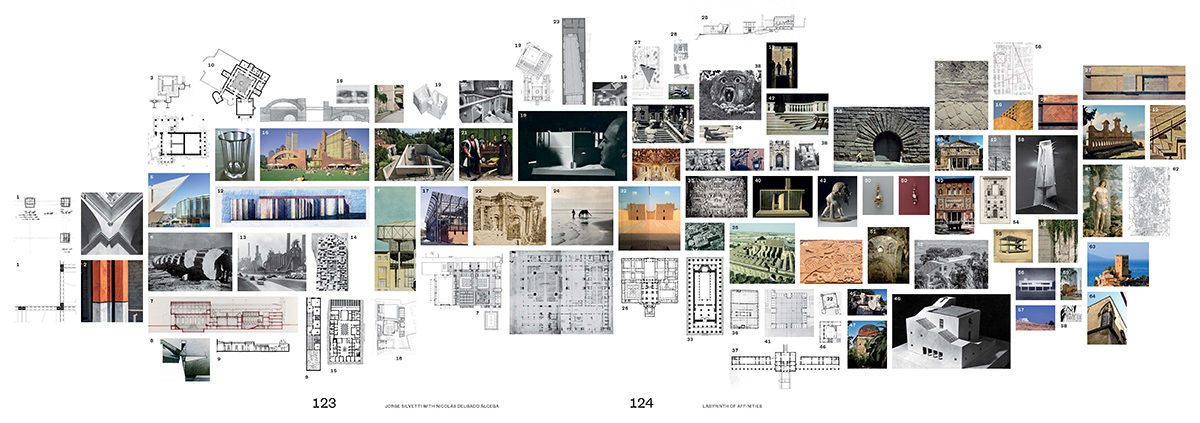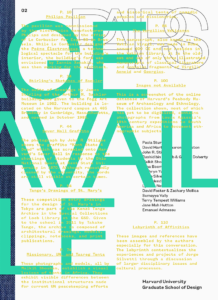 Pairs is a student-led journal at the Harvard Graduate School of Design dedicated to conversations about design that are down to earth and unguarded. Each issue is conceptualized by an editorial team that proposes guests and objects to be in dialogue with one another. The following is an excerpt of a conversation from Issue 02 between Pairs co-founder Nicolás Delgado Álcega (MArch II ’20) and Jorge Silvetti, Nelson Robinson, Jr. Professor of Architecture at the GSD, titled “Labyrinth of Affinities”
Pairs is a student-led journal at the Harvard Graduate School of Design dedicated to conversations about design that are down to earth and unguarded. Each issue is conceptualized by an editorial team that proposes guests and objects to be in dialogue with one another. The following is an excerpt of a conversation from Issue 02 between Pairs co-founder Nicolás Delgado Álcega (MArch II ’20) and Jorge Silvetti, Nelson Robinson, Jr. Professor of Architecture at the GSD, titled “Labyrinth of Affinities”
On Perspective, Anamorphosis, and Repositionings
“The worst labyrinth is not that intricate form that can entrap us forever but a single and precise straight line.”—Jorge Luis Borges, Labyrinths, 1962.
The following conversation developed through a series of periodic exchanges that took place between September 2020 and March 2021. As a series of social events unfolded – at the GSD, in the United States, and around the world—the authors opened up a discussion that began with a set of personal notes that Jorge Silvetti had collected in the months prior. Alarming current events catalyzed a slow discussion, one in which personal experiences, disciplinary issues, and large cultural processes constantly intertwined through an exchange of words and images; one through which the authors, both raised surrounded by a degree of social unrest, sought to make sense of what they saw around them.
This conversation took place amidst Silvetti’s retirement from the GSD after 46 years of involvement in the school. It accompanied the donation process of the Machado & Silvetti archive to the Frances Loeb Library and paralleled a seminar at the GSD in which related issues were engaged through a different mode. It precedes a retrospective exhibition of the work of Machado & Silvetti and has been a sounding board for a new course that Silvetti will teach as a Research Professor in the coming years. It is a conversation between two South Americans from opposite ends of the continent and on opposite ends of their professional careers who are both curious, concerned and stimulated by this moment in the history of architectural culture.
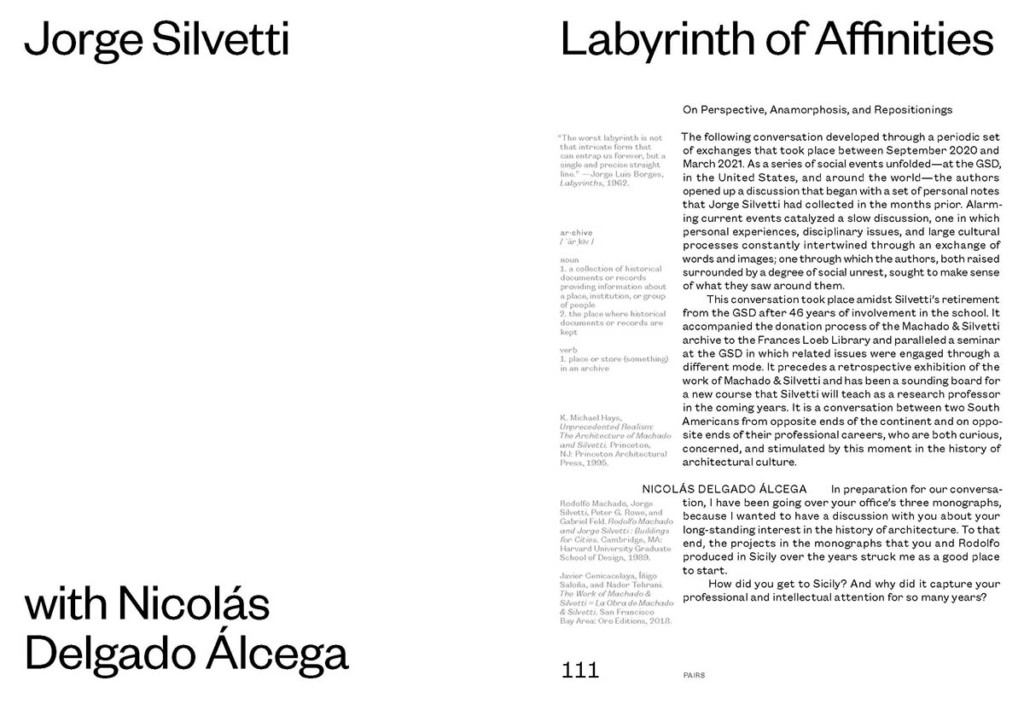
ar·chive | ˈärˌkīv |
noun 1. a collection of historical documents or records providing information about a place, institution, or group of people 2. the place where historical documents or records are kept
verb 1. place or store (something) in an archive
NICOLÁS DELGADO ALCEGA: In preparation for our conversation, I have been going over your office’s three monographs, because I wanted to have a discussion with you about your long-standing interest in the history of architecture. To that end, the projects in the monographs that you and Rodolfo produced in Sicily over the years struck me as a good place to start.
How did you get to Sicily? And why did it capture your professional and intellectual attention for so many years?
K. Michael Hays, Unprecedented Realism: The Architecture of Machado and Silvetti. Princeton, NJ: Princeton Architectural Press, 1995.
Rodolfo Machado, Jorge Silvetti, Peter G. Rowe, and Gabriel Feld. Rodolfo Machado and Jorge Silvetti : Buildings for Cities. Cambridge, MA: Harvard University Graduate School of Design, 1989.
Javier Cenicacelaya, Íñigo Saloña, and Nader Tehrani. The Work of Machado & Silvetti = La Obra de Machado & Silvetti. San Francisco Bay Area: Oro Editions, 2018.
JORGE SILVETTI: Before I answer your question, let me first say that I was chiefly educated within the context of the Western tradition but from a distinctly marginal location. I was raised in Buenos Aires, a city at the bottom of the Western world, in the southernmost tip of the continent. At the 34th parallel south, I was not only literally at the geographic bottom of the world but also on the fringes of the history of Western society. When I say marginal then, I mean simply that I was in a position at an edge farthest away from the centers of cultural dominance.
From Buenos Aires everything was far, particularly those centers of power and their histories. This was amplified by the fact that, back then, people didn’t travel that often to Europe. To do so affordably meant a monthlong journey by boat, and even that option was not available to middle-class families.
Nonetheless, everything I was learning in school—music, history, art—was invariably founded on the Western tradition. It was assumed that everything you were learning was the way it was supposed to be, which I suppose today means “canonical.” But I grew up feeling that whatever my reality was, it was upended from that “normality.” So, my understanding of the “canonical” was always inevitably skewed by the particular angle from where I had been positioned by fate, where distant traditions were intertwined with other local cultural ingredients that fed my mind and imagination. In marginal positions, local cultural pressures are inescapably very active. This is particularly true in the arts, language, and daily customs, whether it’s classical or pop music, painting, literature, cuisine, or local jargon.
po·si·tion | pəˈziSH(ə)n |
noun 1. a place where something is located 2. a particular way in which something is placed or arranged 3. a situation or set of circumstances that affect one’s power to act 4. a person’s point of view or attitude toward something
verb 1. put or arrange something in a particular place or way 2. promote a product 3. portray or regard someone as a particular type of person
All these elements that were bound by location coalesced into my individual cultural profile. They contaminated my understanding and regard for the “canon”—my way of seeing it—and importantly influenced and inspired my creative and intellectual work. I think it all points to my particular, seemingly deviant predilections and interests among the canonical expressions of Western architecture, which are generally found in places that were far from the accepted “center,” be it Athens, Rome, or Paris. Even though Hagia Sophia or El Escorial were presented as part of the canon, I was always inclined to interpret them as marginal. I found them to be anomalies, deviations, or even perversions by which I was fascinated.
re·gard | rəˈɡärd |
noun 1. attention to 2. best wishes
verb 1. consider (something) in a specified way 2. gaze at steadily in a specified fashion
However, these conditions not only determined my interest in certain cases on the edge of the canon but also influenced my reading of works squarely in line with the “canon.” At one point, I even convinced myself that the whole Palladian oeuvre was a peculiar, provincial oddity of the Roman Renaissance. Although I used to be somewhat embarrassed of myself for holding these positions—keeping most to myself—today I am convinced that we can and should present Palladio’s work first and foremost as such. Certainly at least the corpus of his domestic architecture around Vincenza! Those sober, restrained, stuccoed villas qua farms screaming their classical pedigree yet speaking a “dialect” far from Rome and Florence, to which they allude. I think today they become clearer and more powerful when seen this way. It makes them more productive and meaningful in the context of our current concerns. Ultimately, it shows convincingly that the “canon” is an ever changing, layered, and shifting body of models and ideals. Seen this way, Palladio’s work moves quickly from being marginal to becoming central to “the canon,” not only in Italy but all over Europe and eventually North America.
This way of seeing is, really, the indelible mark that this “position”—physical, historical, cultural—left in my persona and the perspective from which I look at the world. And today it explains to me—even if it’s too late for my mother of Tuscan origins to understand!—why I became so enchanted and involved with Sicilian architecture and its intensely hybrid and exuberant artistic pedigree.
per·spec·tive | pərˈspektiv |
noun 1. the art of drawing solid objects on a two-dimensional surface so as to give the correct impression of their height, width, depth, and position in relation to each other when viewed from a particular point 2. particular attitude toward or way of regarding something; a point of view
NDA: You’re suggesting Sicily has a similar condition to that of Buenos Aires? Of being at the edge of a culturally dominant center that it is in contact with?
JS: In some ways, say in relation to Rome, Florence, or Venice during classical periods, yes. Sicily is a place where this phenomenon is very much a part of the island’s cultural condition and history. When viewed from the position of dominant cultural centers, it is a culture that has been marginal to other centralities for millennia: to the Phoenicians, the ancient Greeks, the Romans, the Byzantines, the Normans, the Spanish, and so on.
anamorphic | ˈˌanəˈˌmôrfik |
adjective 1. denoting or relating to projection or drawing distorted by anamorphosis
So, Sicily is a place where all major cultures converged, but for which Sicily was never a particular center. And yet, when you see things from Sicily, the island prompts its own form of centrality. This duality is inevitable in Sicily. On a map, we can see it as an ineludible roadblock in the Mare Nostrum upon which all Mediterranean cultures stumbled and (accidentally) left their marks. But conversely, we can also see it as a “center” of Mediterranean culture, which collected the tolls paid by all the passersby that helped create and enrich its own particular cultural makeup. The deep layers of cultural stratification caused by this geographical, cultural condition have produced something unique in Sicily that is still palpable today.
an·a·mor·pho·sis | ˌanəˈmôrfəsəs |
noun 1. a distorted projection or drawing which appears normal when viewed from a particular point or with a suitable mirror or lens 2. the process by which anamorphic images are produced
Nowhere is this clearer than in Sicilian Baroque architecture, a local strain of what was otherwise a Roman cultural epiphenomenon. In Sicily, the Roman Baroque is appropriated and completely reinvented. Its exaggeration, ebullience, and luxuriance goes far beyond Rome’s, and its urban ambition is much more comprehensively realized. The architectural and urban planning experiments of the Val di Noto, as well as the codevelopment of sculpture, ornament, and stucco in Palermo has few parallels elsewhere during this time.
The same can be said of the so-called “Norman architecture,” a short period in the late 11th and most of the 12th century, where an original architecture was created by the fusion and coalescence of Byzantine, Islamic, and Norman architectural streams.
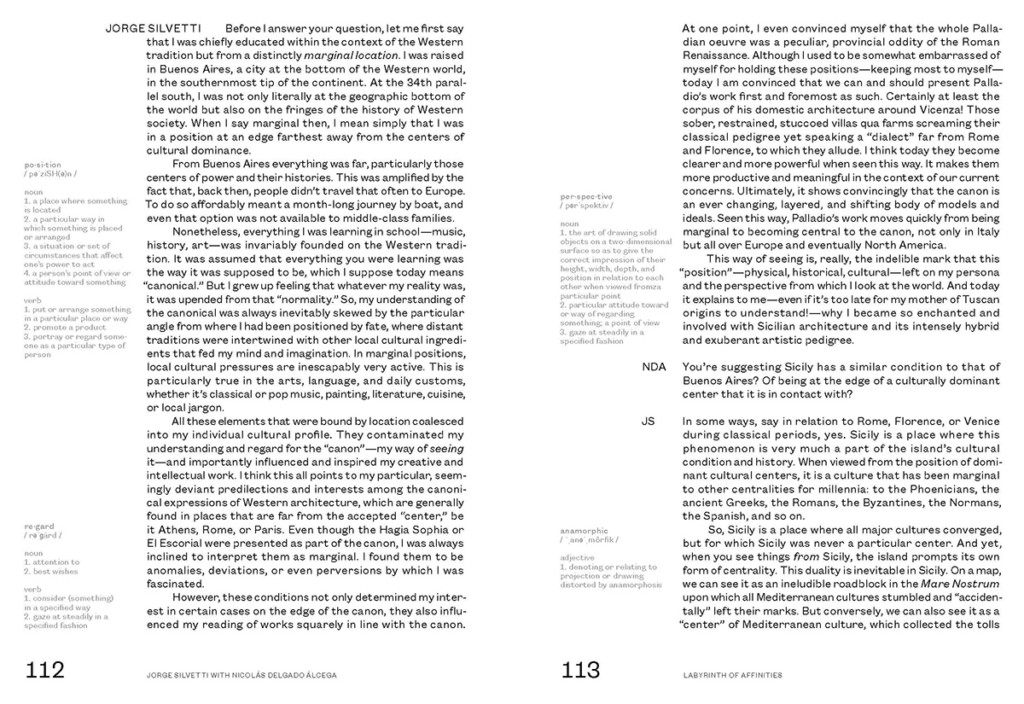
NDA: For how long were you actually involved with research and projects in Sicily?
JS: It was about 11 years. We would spend every moment we didn’t have to be in Boston in Sicily. And when we were in Boston, there was usually ongoing work for Sicily at the office. It was undoubtedly one of the most formative experiences of my life, professionally and intellectually. I don’t think I learned more about architecture in any other place. Sicily is a place where I understood so much about how cultures are put in motion and transformed.
NDA: In a way, your journeys to Sicily sound like the more canonical pilgrimage to Rome, but instead of offering the “definitive” references of antiquity or the Baroque, Sicily offered uniquely “derivative” ones.
JS: Well, firstly I would never call what Sicily produced a “derivative” type of work, which has a derogatory connotation. This is architecture that I would call original, fresh, and powerful. As to your other point about an alternative canonical pilgrimage, I’m not so sure about that. I knew Rome well before I went to work in Sicily. However, by the time I got to the American Academy in 1986, I had been involved in Sicily for four or five years. So at that point, it was in fact Sicily that tainted a posteriori my mature understanding of the Rome I (thought) I knew well and not the other way around.
NDA: We normally judge what is “on the edge” by contrasting it with what is at the center, with the canonical reference. I think this idea of reading things the other way around, as you are describing, is interesting. Looking back at the reference or origin point from what you’ve learned at the edge.
I guess if you think about it, it’s the only way. We are always seeing from our point of view, with all of the baggage that this implies.
JS: Absolutely. This is actually at the core of what the so-called “Western tradition” truly is, or at least, that is how I have come to understand it. I think this is the way we should always position ourselves to look at any cultural practice.
Now that I have been relieved of most of my academic responsibilities, I’ve been working on a seminar that tries to reframe what we understand by the Western tradition and leaves behind this notion of “canon,” which I don’t believe is really a solid, homogeneous ,and compact cultural phenomenon. It is an attempt to reposition my thinking around the topics that have occupied my mind as a teacher and practitioner, which has been fueled and energized with great impetus in the past year since we have all felt the need to move at another pace with sharper focus and new objectives.
My main intent is to dismantle the idea that the Western tradition is a monolithic, static, and intrinsically problematic thing, as it has become customary to describe it. While this is not a particularly original idea—scholars like Salvatore Settis have dealt with this idea at great depth already—I think we have much to gain by restating this fact. I believe we should try to further understand the ways in which this tradition is an ever changing, highly heterogeneous, macro cultural formation that has been around for thousands of years. The Western tradition is a cultural phenomenon that has had quite a few dominant strains at different times and has always been fueled, energized, and transformed by the internal dynamics of its intrinsic diversity, by the interplay of its component parts.
What I hope to achieve with the course is to take this tradition and see how once “marginal” or “dominated” component strains of its diversity have at times advanced to become dominant themselves—Palladio, again . . . For me, cases of this kind are evidence that the attempts we are undertaking to respond to today’s issues require—or better, deserve—reconsideration. I think that by repositioning our strategic intellectual perspective in order to productively work from within this collective of cultural strains—instead of taking on an approach of rejection—our capacity to amplify certain strains is much higher.
re·po·si·tion | ˌrēpəˈziSHən |
verb 1. place in a different position 2. adjust or alter the position of
I’m actually of the opinion that going as far back as the Acropolis of Athens—two and a half millennia behind us—gives us incredible opportunities to study strains that deal with issues that are at the forefront of our concern right now, whether it’s related to identity, diversity, inclusion, or justice. In fact, the course may be called “The Acropolis of Athens and Its Consequences.”
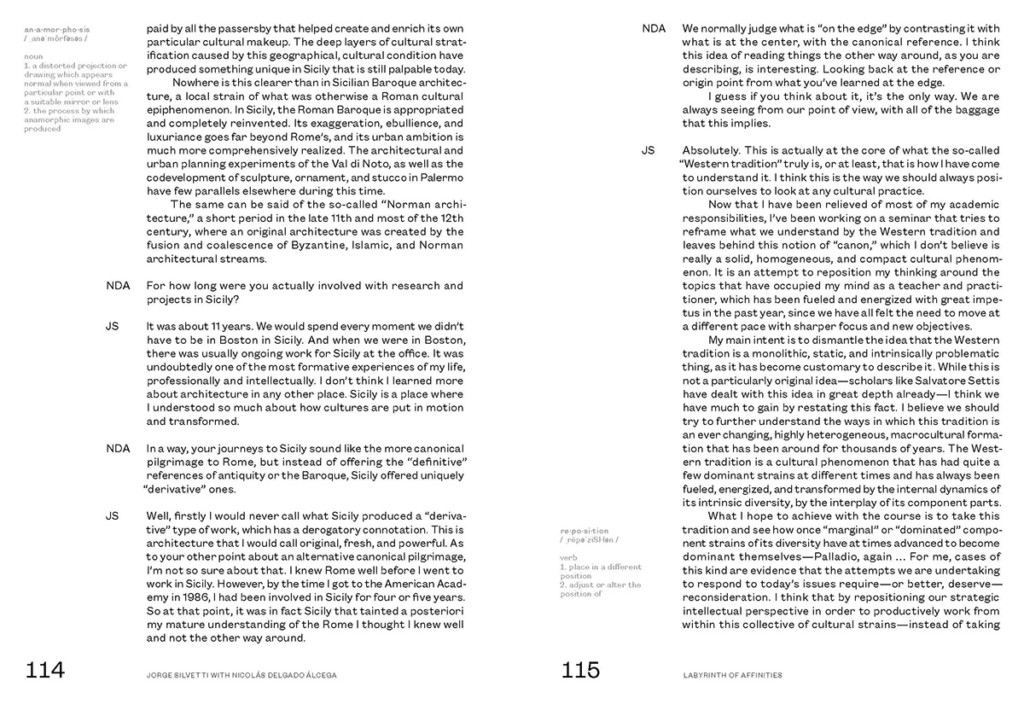
NDA: It’s exciting to think that architecture can play a role in these changing balances of power. But can it actually operate at the speed necessary for it to be proactive in these processes?
JS: I think we have to understand architecture as part of the constellation of cultural products that define a moment. In academia, we lately tend to fall under the temptation of making architecture overreach into other domains of society and culture in which other practices are more effective and powerful. But if we look at cases in a nuanced way, I believe we can see many of these forces at play in the making of architecture.
A lot of the interests I will be exploring in the seminar began developing years ago in some option studios I taught at the GSD. In the courses, we would deal directly with the profound and tense issues of cultural identity and diversity that characterize our age through many cases, including, for instance, the Indigenous Guaraní cultural territory, a place that exists at the intersection of several South American nation-states.
We would take as a starting point the physical remains of the Misiones jesuíticas: a century-and-a-half-long colonial cultural project that spanned the 17th and 18th century. The misiones were the result of interactions between European architectural culture and local practices. The combination of these two traditions under the extreme environmental conditions of this area produced a form of heritage that differed greatly from the better-known, typical outcomes of the Spanish-colonial sociopolitical models prevalent at the time.
There was clearly at play here a power dynamic in which one of the parties was still under the control of another. And yet, the remains of the architecture that we still see there are the result of an act of cultural negotiation, one which had ultimately produced something altogether new, distinct, and extraordinary from either perspective. The architecture did not vindicate any specific individual or wholeheartedly upend a power balance; the outcome was not black, white, or gray. But I do believe that what it manifested was a swerve in the direction of an altogether new cultural construct.
“There are those who want a text (an art, a painting) without a shadow, without the ‘dominant ideology’; but this is to want a text without fecundity, without productivity, a sterile text . . . The text needs its shadows; this shadow is a bit of ideology, a bit of representation, a bit of subject: ghosts, pockets, traces, necessary clouds: subversion must produce its own chiaroscuro.” —Roland Barthes, The Pleasure of the Text, 1975.
Something that I’ve learned from all of these experiences is that we are always influenced and determined by a dominant way of seeing things. But that to be critical of this dominance within a specific practice, which is what most of us always want to do anyway, we need to do so from within as practitioners of such practice. We can’t just stand there, reflecting on it passively or taking an outsider’s perspective; you cannot really walk away from the cultural constructs you are embedded into, no matter how much you disagree with them.
NDA: I’m curious how you dealt with all these questions in the studio format, where you must move beyond analysis and critique into specific design proposals.
JS: We did what studios are best suited to do: respond to intellectual demands through design by engaging a specific set of circumstances and needs. The “design mode” of research and pedagogy gives us a unique perspective and understanding of society: its history, its present, and its possible futures. In all these studios I made sure that we amplified and diversified the students’ perspectives on all the areas of knowledge, art, and politics that converged on our problem at hand. But I also made it so that they had no alternative in confronting their proposed interventions other than by addressing these issues with exclusively architectural means.
I think that broadening our understanding should not be confused with studio formats prevalent today in which architecture is just a support scaffolding to principally address topics provided by the field of technology or the politics of the humanities. I believe that making architecture the inescapable protagonist of an architectural education is today an ethical imperative. All these other topics should be a part of the questions we ask ourselves in the studio but not the ultimate goal.
NDA: In a recent conversation with Sarah M. Whiting for Pairs 01, she pointed out that design teaching was essentially about dialogue because discourse advances through conversation, regardless of the form it takes. When I reflect on some of the theory seminars that you have taught recently, I remember them as exactly that: agglomerations of concepts, ideas, and references in the process of finding shape; propositions, questions, and observations more than definitive answers. Perhaps what was most refreshing about the experience was seeing how we can revisit the history of our discipline and, by virtue of the way we compose and connect its parts, find new and useful ways of learning from it. It is perhaps the closest approach to Aby Warburg’s methodology that I encountered in my years as a student.
Maybe because you are not a historian but rather a designer with a passion for history, you are constantly trying to understand why a given architect made certain decisions. I think more than ever this is a worthy undertaking. It enables us to look at the history of our discipline as a set of exercises performed by people trying to make the right choice given their priorities amid complicated and often contradictory constraints. And it gives us the hindsight to evaluate the consequence or impact of these decisions in time. With so many anti–status quo priorities implicit in discussions in schools of architecture today, this feels incredibly useful.
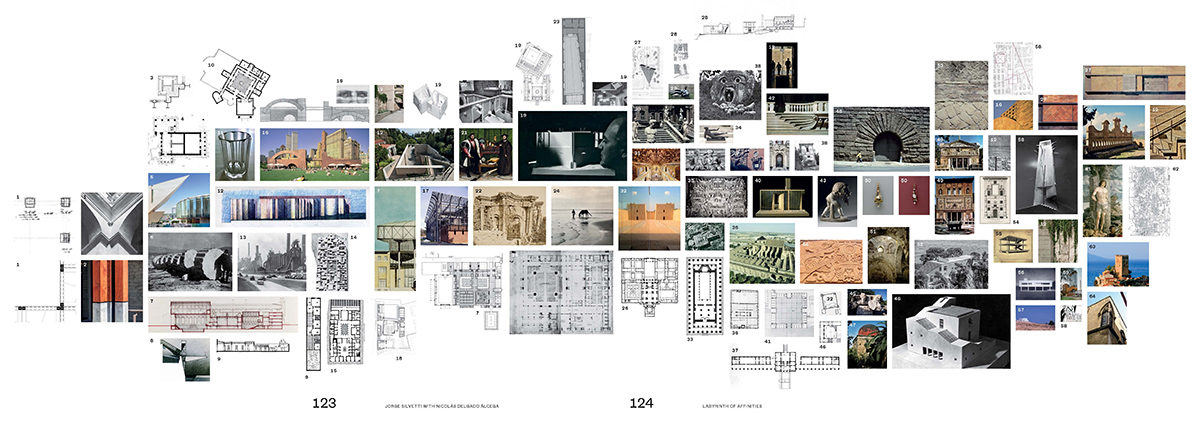
JS: Yes, that’s the way teaching the history of architecture should be approached in a school of architecture! One of the pedagogical contributions that I am most proud of is the work that Howard Burns and I did at the GSD to create the course “Buildings, Texts, and Contexts (BTC),” which was then amplified by the contributions of Michael K. Hays and Wilfried Wang at the turn of the millennium. We essentially broke away from the idea of the survey course as a way to teach architectural history at the graduate level, since we thought it was unnecessary, in favor of the approach you are describing.
We imposed surveys as a prerequisite to admission to the program and developed a way to teach history that was specifically conceived and designed for graduate architecture programs. Until that point, history in architecture schools was taught in the same way as in fine arts schools. We thought this was not the best approach because the courses were too distant from the studios and lost all relation to the design process, which is ultimately one of the chief concerns of our education.
Howard and I argued that the history of architecture in a professional school had to be taught jointly and on an equal level by one architect and one historian. We were the first to try this out, and the result was fantastic. Though we started it at the GSD, I think it did have some repercussions in other graduate programs across the country.
Each week we taught a case, usually a single building, and every once in a while a text. On Tuesday, I would start off by looking at the building in itself. On Thursday, Howard would then bring in more of the historical context. But he would do so by extending out from the piece of architecture (or text) under scrutiny and going only as far as necessary to hypothesize what the actual process of design had been. So, we would look at the building from the inside out, trying to reconstruct, in a somewhat speculative way, what was going through the mind of the architect in the creative process. This, by the way, is another example of how one can position oneself within what one is studying, analyzing, or interpreting.
It was a total success because it really made the cases useful and accessible to us as architects tasked with our own creative endeavors, with our own need to respond to the myriad of conditions in our context in order to give shape to a specific building or space.
NDA: Did your interest in the “marginal” expressions of Western architecture percolate into the list of cases?
JS: Of course! One of the first things we did was incorporate cases like El Escorial or the Mosque of Córdoba as breakthrough dislocations within Western culture. These were buildings that were discussed in conventional courses but always in passing. Much of what I’ve shared with you today was less clear to me back then, but this urge to push these cases toward the center was there, I guess.
By placing these types of buildings in equal position among canonical exemplars, we make them act as moments of epiphany in our understanding of the cultural dynamics of architecture. The mosque was a building done entirely with Roman technology and Roman architectural component pieces and yet a complete invention for an emerging religious and political power, a type of building that had never been seen anywhere else. It was also a building that underwent expansions and modifications across centuries, adapting itself to rituals and a religious culture in evolution. Its later history is actually its transformation from mosque to cathedral, which I think is an extraordinary cultural phenomenon to witness and which deals with many issues that are resurfacing in our contemporary concerns.
NDA: I think our generation feels an urgency to reinvent many of the conventions that we take for granted in order to respond to new conditions that we are alarmed by. And I think this holds true whether we talk about the way we build, practice, foster community, or govern.
To me, the events that unfolded around the issue of police brutality in the US last year are a very clear example of this. But they also showed that the desire to dismantle and reassemble anew or to radically restructure something is very complex and nuanced. It is ultimately an act of negotiation between a new set of aspirations and an establishment that it is often at odds with.
Do you think there are tangible ways to use the sort of scholarship we have discussed today to seriously deal with issues like the representation of cultural minorities or marginalized segments of society in our fields?
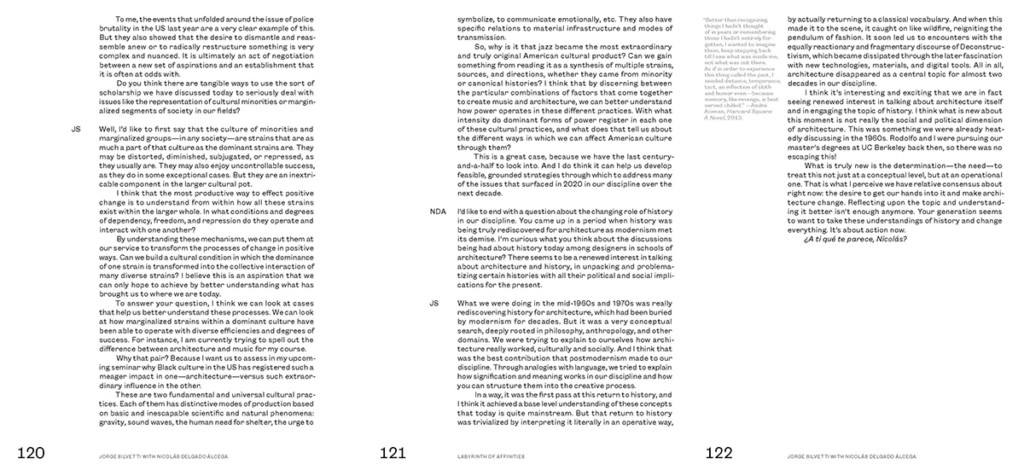
JS: Well, I’d like to first say that the culture of minorities and marginalized groups—in any society—are strains that are as much a part of that culture as the dominant strains are. They may be distorted, diminished, subjugated, or repressed, as they usually are. They may also enjoy uncontrollable success, as they do in some exceptional cases. But they are an inextricable component in the larger cultural pot.
I think that the most productive way to effect positive change is to understand from within how all these strains exist within the larger whole. In what conditions and degrees of dependency, freedom, and repression do they operate and interact with one another?
By understanding these mechanisms, we can put them at our service to transform the processes of change in positive ways. Could we build a cultural condition in which the dominance of one strain is transformed into the collective interaction of many diverse strains? I believe this is an aspiration that we can only hope to achieve by understanding better what has brought us to where we are today.
To answer your question, I think we can look at cases that help us better understand these processes. We can look at how marginalized strains within a dominant culture have been able to operate with diverse efficiencies and degrees of success. For instance, I am currently trying to spell out the difference between architecture and music for my course.
Why that pair? Because I want us to assess in my upcoming seminar why Black culture in the US has registered such a meager impact in one—architecture—versus such extraordinary influence in the other.
These are two fundamental and universal cultural practices. Each of them has distinctive modes of production based on basic and inescapable scientific and natural phenomena: gravity, sound waves, the human need for shelter, the urge to symbolize, to communicate emotionally, etc. They also have specific relations to material infrastructure and modes of transmission.
So, why is it that jazz became the most extraordinary and truly original American cultural product? Can we gain something from reading it as a synthesis of multiple strains, sources, and directions, whether they came from minority or canonical histories? I think that by discerning between the particular combinations of factors that come together to create music and architecture, we can better understand how power operates in these different practices. With what intensity do dominant forms of power register in each one of these cultural practices, and what does that tell us about the different ways in which we can affect American culture through them?
This is a great case, because we have the last century-and-a-half to look into. And I do think it can help us develop feasible, grounded strategies through which to address many of the issues that surfaced in 2020 in our discipline over the next decade.
NDA: I’d like to end with a question about the changing role of history in our discipline. You came up in a period when history was being truly rediscovered for architecture as modernism met its demise. I’m curious what you think about the discussions being had about history today among designers in schools of architecture? There seems to be a renewed interest in talking about architecture and history, in unpacking and problematizing certain histories with all their political and social implications for the present.
JS: What we were doing in the mid-1960s and 1970s was really rediscovering history for architecture, which had been buried by modernism for decades. But it was a very conceptual search, deeply rooted in philosophy, anthropology, and other domains. We were trying to explain to ourselves how architecture really worked, culturally and socially. And I think that was the best contribution that postmodernism made to our discipline. Through the analogies with language, we tried to explain how signification and meaning works in our discipline and how you can structure it into the creative process.
In a way, it was the first pass at this return to history, and I think it achieved this base level understanding of these concepts that today is quite mainstream. But that return to history was trivialized by interpreting it literally in an operative way, by actually returning to a classical vocabulary. And when this made it to the scene, it caught on like wildfire, reigniting the pendulum of fashion. It soon led us to encounters with the equally reactionary and fragmentary discourse of Deconstructivism, which became dissipated through the later fascination with new technologies, materials, and digital tools. All in all, architecture disappeared as a central topic for almost two decades in our discipline.
I think it’s interesting and exciting that we are in fact seeing renewed interest in talking about architecture itself and in engaging the topic of history. I think what is new about this moment is not really the social and political dimension of architecture. This was something we were already heatedly discussing in the 1960s. Rodolfo and I were pursuing our master’s degrees at UC Berkeley back then, so there was no escaping this!
What is truly new is the determination—the need—to treat this not just at a conceptual level, but an operational one. That is what I perceive we have relative consensus about right now: the desire to get our hands into it and make architecture change. Reflecting upon the topic and understanding it better isn’t enough anymore. Your generation seems to want to take these understandings of history and change everything. It’s about action now. ¿A ti qué te parece, Nicolás?
“Better than recognizing things I hadn’t thought of in years or remembering those I hadn’t entirely forgotten, I wanted to imagine them, keep stepping back till I saw what was inside me, not what was out there. As if in order to experience this thing called the past, I needed distance, temperance, tact, an inflection of sloth and humor even—because memory, like revenge, is best served chilled.” —André Aciman, Harvard Square: A Novel, 2013.
Pairs 02 was edited by Nicolás Delgado Alcega (MArch II ‘20), Vladimir Gintoff (MArch I ‘21, MUP ‘21), Kimberley Huggins (MLA I ‘20) and Kyle Winston (MArch I ‘22) with the support of Dean Sarah M. Whiting and the Harvard University Graduate School of Design. Purchase Pairs 02.
